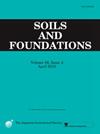Experimental study for modeling the unloading swelling behavior of Ariake clay
IF 3.3
2区 工程技术
Q2 ENGINEERING, GEOLOGICAL
引用次数: 0
Abstract
Due to economic and demographic growth, there is a rising demand for land reclamation in coastal cities of East and Southeast Asia. Marine clays typically play a critical role in these projects, and the deformation characteristics of marine clays become a crucial problem in terms of the quality of the subsoil conditions. The long-term loading behavior of marine clays has been studied by many researchers. However, relatively few studies have been done on the unloading behavior of these clays after preloading; and thus, the strain rate dependency on the unloading behavior of marine clays remains unclear. The aim of this study was to accumulate experimental data on the unloading behavior of marine clays and to develop a strain rate-based model for improving the accuracy of the predictions of the swelling behavior of marine clays during unloading. The authors conducted a series of constant rate of strain (CRS) consolidation tests from loading to unloading, and long-term unloading oedometer tests on Ariake clay, which is a well-known sensitive marine clay, to observe the swelling behavior during in unloading. The preloading time, corresponding to different strain rates at the end of preloading, was controlled to elucidate the effect of the stress history. Moreover, instead of parameter σ′p (preconsolidation pressure) for the normal consolidation visco-plastic behavior, the authors developed and proposed a new visco-plastic model by introducing the concept of a plastic rebound boundary and a new parameter R for swelling behavior during unloading. Parameter R represents the normalized distance from the current stress state to the plastic rebound boundary in logarithmic effective consolidation stress. Therefore, the visco-plastic model for the behavior in the loading stage was developed into the swelling visco-plastic behavior in the unloading stage for Ariake clay. Comparing the simulation and test results, the simplified visco-plastic swelling model was found to agree well with the test results.
Ariake黏土卸荷膨胀特性模拟试验研究
由于经济和人口的增长,东亚和东南亚沿海城市对土地开垦的需求不断增加。海相粘土通常在这些工程中起着关键作用,海相粘土的变形特性成为影响地基条件质量的关键问题。海相粘土的长期加载特性已经得到了许多研究者的研究。然而,对预压后土体的卸荷特性研究相对较少;因此,应变速率对海相粘土卸荷特性的依赖关系尚不清楚。本研究的目的是积累海相粘土卸载行为的实验数据,并建立基于应变率的模型,以提高海相粘土卸载过程中膨胀行为预测的准确性。对著名的海洋敏感黏土Ariake粘土进行了从加载到卸载的一系列恒应变速率固结试验和长期卸载试验,观察了其在卸载过程中的膨胀行为。控制预压结束时不同应变速率对应的预压时间,以阐明应力历史的影响。此外,作者提出了一个新的粘塑性模型,并引入了塑性回弹边界的概念和卸载过程中膨胀行为的新参数R,取代了正常固结粘塑性行为的参数σ ' p(预固结压力)。参数R表示对数有效固结应力下当前应力状态到塑性回弹边界的归一化距离。因此,有明黏土加载阶段的粘塑性模型可发展为卸载阶段的膨胀粘塑性模型。仿真结果与试验结果比较,发现简化后的粘塑性膨胀模型与试验结果吻合较好。
本文章由计算机程序翻译,如有差异,请以英文原文为准。
求助全文
约1分钟内获得全文
求助全文
来源期刊

Soils and Foundations
工程技术-地球科学综合
CiteScore
6.40
自引率
8.10%
发文量
99
审稿时长
5 months
期刊介绍:
Soils and Foundations is one of the leading journals in the field of soil mechanics and geotechnical engineering. It is the official journal of the Japanese Geotechnical Society (JGS)., The journal publishes a variety of original research paper, technical reports, technical notes, as well as the state-of-the-art reports upon invitation by the Editor, in the fields of soil and rock mechanics, geotechnical engineering, and environmental geotechnics. Since the publication of Volume 1, No.1 issue in June 1960, Soils and Foundations will celebrate the 60th anniversary in the year of 2020.
Soils and Foundations welcomes theoretical as well as practical work associated with the aforementioned field(s). Case studies that describe the original and interdisciplinary work applicable to geotechnical engineering are particularly encouraged. Discussions to each of the published articles are also welcomed in order to provide an avenue in which opinions of peers may be fed back or exchanged. In providing latest expertise on a specific topic, one issue out of six per year on average was allocated to include selected papers from the International Symposia which were held in Japan as well as overseas.
 求助内容:
求助内容: 应助结果提醒方式:
应助结果提醒方式:


